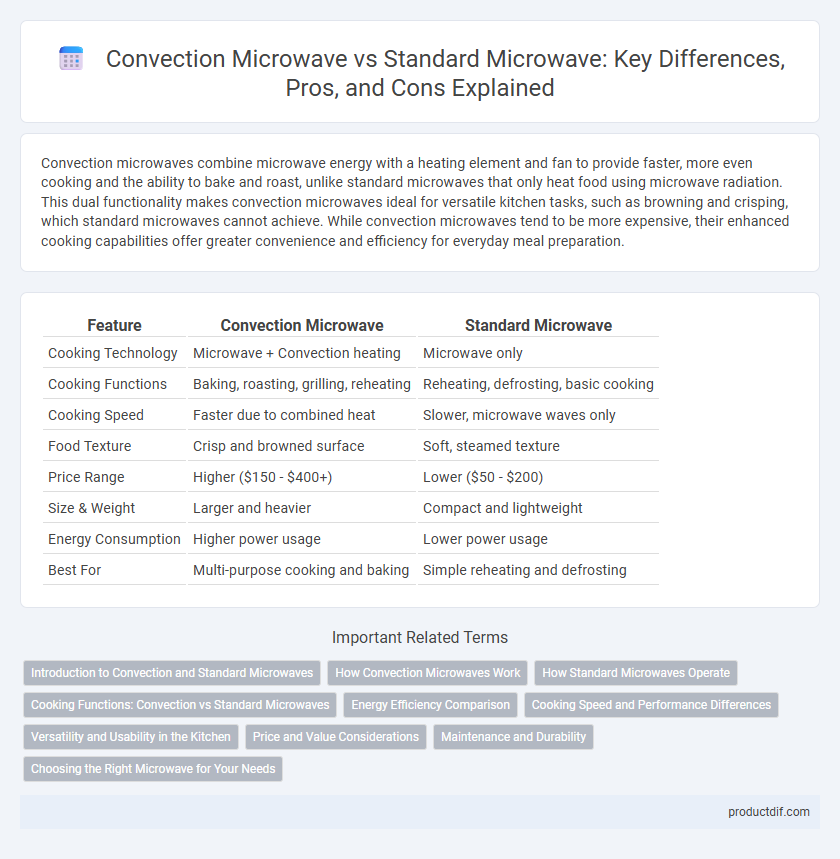Convection microwaves combine microwave energy with a heating element and fan to provide faster, more even cooking and the ability to bake and roast, unlike standard microwaves that only heat food using microwave radiation. This dual functionality makes convection microwaves ideal for versatile kitchen tasks, such as browning and crisping, which standard microwaves cannot achieve. While convection microwaves tend to be more expensive, their enhanced cooking capabilities offer greater convenience and efficiency for everyday meal preparation.
Table of Comparison
| Feature | Convection Microwave | Standard Microwave |
|---|---|---|
| Cooking Technology | Microwave + Convection heating | Microwave only |
| Cooking Functions | Baking, roasting, grilling, reheating | Reheating, defrosting, basic cooking |
| Cooking Speed | Faster due to combined heat | Slower, microwave waves only |
| Food Texture | Crisp and browned surface | Soft, steamed texture |
| Price Range | Higher ($150 - $400+) | Lower ($50 - $200) |
| Size & Weight | Larger and heavier | Compact and lightweight |
| Energy Consumption | Higher power usage | Lower power usage |
| Best For | Multi-purpose cooking and baking | Simple reheating and defrosting |
Introduction to Convection and Standard Microwaves
Convection microwaves combine traditional microwave heating with a built-in fan and heating element, allowing for faster cooking and browning, ideal for baking and roasting. Standard microwaves use electromagnetic waves to heat food primarily through water molecule excitation, offering quick reheating and simple cooking tasks. Understanding these distinct technologies helps consumers choose appliances that match their cooking preferences and needs.
How Convection Microwaves Work
Convection microwaves combine traditional microwave energy with a built-in heating element and fan, circulating hot air to cook food evenly and achieve a crispy texture. This hybrid technology allows for baking, roasting, and grilling, functions standard microwaves cannot perform due to their sole reliance on microwave radiation. The convection feature enhances cooking versatility by ensuring heat penetration beyond the surface, resulting in uniform cooking and improved texture.
How Standard Microwaves Operate
Standard microwaves operate by emitting electromagnetic waves at a frequency of approximately 2.45 GHz, which agitate water molecules in food to generate heat. This process relies on a magnetron to produce microwaves that penetrate food items, cooking them from the inside out without preheating. Unlike convection microwaves, standard models do not incorporate fans or heating elements for browning or crisping food surfaces, limiting their functionality to reheating, defrosting, and simple cooking tasks.
Cooking Functions: Convection vs Standard Microwaves
Convection microwaves combine microwave energy with a built-in convection fan and heating element, enabling baking, roasting, and crisping in addition to standard reheating and defrosting functions. Standard microwaves primarily rely on microwave radiation for quick heating and are limited to tasks like reheating, defrosting, and simple cooking without browning or crisping capabilities. The convection feature expands cooking versatility, making these appliances suitable for preparing a wider variety of dishes with improved texture and flavor.
Energy Efficiency Comparison
Convection microwaves generally consume more energy than standard microwaves due to their combined heating elements and fan system, which enable baking and roasting functions besides simple reheating. Standard microwaves feature simpler technology that typically uses less power, averaging around 600-1200 watts, whereas convection models can range from 1200 to 1800 watts. Energy efficiency ratings and usage patterns should be considered, as convection microwaves offer multifunctionality but may increase electricity costs compared to standard microwaves optimized for quick heating.
Cooking Speed and Performance Differences
Convection microwaves combine microwave energy with a heating element and fan, enabling faster cooking times and more even browning compared to standard microwaves. Standard microwaves rely solely on microwave radiation to heat food, resulting in quicker reheating but less effective baking or roasting. Users experience improved cooking versatility and better performance for complex dishes with convection microwave models.
Versatility and Usability in the Kitchen
Convection microwaves offer enhanced versatility by combining traditional microwave cooking with convection oven capabilities, allowing users to bake, roast, and grill in addition to reheating and defrosting. Their usability in the kitchen is elevated through multi-function settings that streamline meal preparation, reducing the need for multiple appliances. Standard microwaves, while efficient for basic heating and defrosting, lack the comprehensive cooking options that convection models provide, limiting their functionality in diverse culinary applications.
Price and Value Considerations
Convection microwaves generally come with a higher price tag compared to standard microwaves due to their advanced cooking technology that combines microwave energy with a heating element and fan for even browning and baking. Despite the increased initial investment, convection microwaves offer greater versatility and can replace multiple appliances, providing better long-term value for users who regularly bake or roast. Standard microwaves are more affordable and suitable for simple reheating tasks, making them a cost-effective choice for basic cooking needs without the extra features and capabilities.
Maintenance and Durability
Convection microwaves generally require more maintenance due to their additional heating elements and fan systems, which may need periodic cleaning and occasional repairs. Standard microwaves tend to have fewer components, making them easier to maintain and often more durable over time with less risk of mechanical failure. Regular cleaning of the interior and vents is crucial for both types to ensure longevity and optimal performance.
Choosing the Right Microwave for Your Needs
A convection microwave combines microwave heating with a built-in fan and heating element to offer both traditional microwave cooking and convection baking, making it ideal for versatile kitchen tasks such as roasting, baking, and grilling. Standard microwaves excel in quick reheating and simple cooking processes, providing efficiency and convenience for everyday use without the added bulk or cost of convection features. Selecting the right microwave depends on your cooking style, available kitchen space, and whether you prioritize multifunctionality or straightforward microwave performance.
Convection microwave vs standard microwave Infographic

 productdif.com
productdif.com